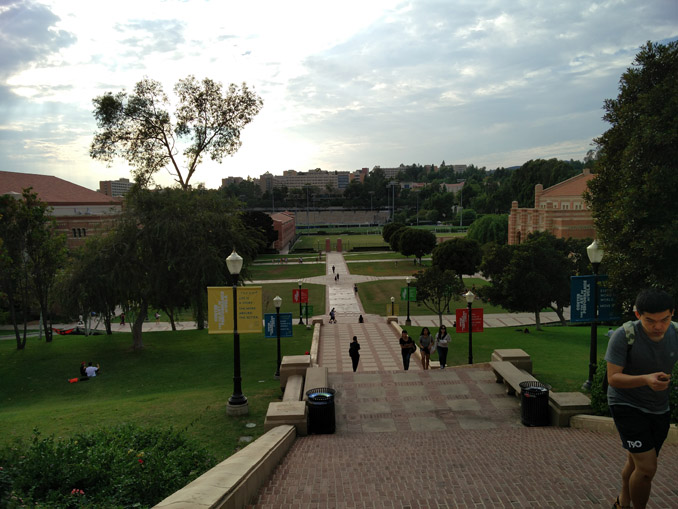The OnePlus 2 Review
by Brandon Chester on December 14, 2015 8:00 AM EST- Posted in
- Smartphones
- Mobile
- OnePlus
- OnePlus 2
Camera Architecture
When the OnePlus One was released one of its most notable features was its camera. At its price, being able to include Sony's IMX214 camera sensor was quite notable. This time around OnePlus is playing in a higher price bracket, and the stakes have been raised due to greater competition. With that being said, the camera is definitely one of the areas I see executed poorly on many non-flagship phones, either due to a poor camera sensor, or more frequently, a poor ISP and inadequate image processing.
| OnePlus One | OnePlus 2 | |
| Front Camera Resolution | 5MP | |
| Front Camera Sensor | Omnivision OV5648 (1/4", 1.4µm) |
|
| Front Camera Aperture | f/2.0 | f/2.0 |
| Rear Camera Resolution | 13MP | |
| Rear Camera Sensor | Sony IMX214 (1/3.06") |
Omnivision OV13860 (1/2.6") |
| Rear Camera Focal Length | 28mm eff | |
| Rear Camera Aperture | f/2.0 | |
The OnePlus 2 retains the OV5648 front-facing camera from the OnePlus One, along with the same lens arrangement. The rear camera now uses an OmniVision sensor as well, which is a departure from the Sony sensor used on the OnePlus One. While some may see this as a downgrade due to Sony's reputation as a great camera sensor manufacturer, I don't think there's any inherent downgrade in moving to an OmniVision sensor. On top of that, we're actually talking about an increase in sensor size from a 1/3.06" format to a 1/2.6" format, which represents a move from 1.12 to 1.3 micron pixels. These aren't as large as those found in a device like the Nexus 5X, but they're larger than the standard 1.12 micron pixels used in the sensors for most flagship smartphones. OnePlus's decision represents another OEM deciding to increase pixel size to improve sensitivity rather than increasing spatial resolution.
Still Image Testing
Due to some less than optimal weather in my area I'll be using the photo comparisons that Josh has taken for his reviews when evaluating the OnePlus 2. In a way this is good, as it means that the OnePlus One is available for comparison, which is a very relevant topic in this circumstance due to its issues with image processing. However, it does mean that the Nexus 5X isn't available in the comparison, which is an unfortunate but worthwhile compromise in this case.
To begin, I'll start with discussing the image quality when taking photos in the daylight with the OnePlus 2, followed by looking at how it fares during the night.
| Daytime Photography |
When taking photos during the day, the OnePlus 2 exhibits some improvements over its predecessor, but some regressions as well. The OnePlus One had some notorious processing issues, and one of the most prominent was how chroma noise would be plainly visible even in scenes with ample lighting. In this scene one can notice that the noise across the frame has been reduced dramatically. While this is good in a sense, OnePlus seems to have gone a bit overboard. Looking at the grass and the textures of the walkway one can see that the amount of detail is reduced compared to the OnePlus One. This is easily visible in the grass, where the heavy noise reduction has turned it into a featureless green smear.
As far as sharpness goes, the OnePlus 2 is definitely an improvement over the OnePlus One in the areas where noise reduction hasn't caused havoc. Examining the tree in the top left of the frame makes this quite apparent, with the OnePlus 2 maintaining the sharpness of the individual branches, and the OnePlus One producing a much fuzzier rendition.
Overall, if I had to choose between the OnePlus One and the OnePlus 2 as a day time camera, I would probably go with the OnePlus 2 simply due to the fact that the chroma noise in the photos taken with the OnePlus One is incredibly distracting. OnePlus definitely has room to improve their processing by toning down the noise reduction a bit in order to better preserve the detail of leafy foliage and grass. I think that phones like the Nexus 5X that offer better image quality at this price point, but they come with their own caveats as well such as having to use HDR+ mode on the Nexus 5X which greatly lengthens the capture time.
| Low Light Scene 2 |
In night time photography the OnePlus 2 makes further gains over its predecessor. When looking at the shot it's immediately obvious how much more detail is retained on the OnePlus 2, and there's none of the distracting chroma noise and smearing that exists in the OnePlus One's photo. When comparing the OnePlus 2 to other smartphones it becomes clear that it's not as good as the latest flagship devices like the Galaxy Note5 and the LG G4, but it still ends up being fairly good, and bests smartphones like the iPhone 6.
It's clear that OnePlus was aware of the problems with image processing on the OnePlus One, and the quality of photos taken with the OnePlus 2 is much better. They definitely have room to improve by toning down noise reduction which would allow them to preserve more fine details in foliage, but as it is now the camera still outputs fairly good images for a phone of this price.
Video Recording
The OnePlus 2 offers three modes for recording video. There's a 720p mode, a 1080p mode, and a UHD mode. I'll just be focusing on the latter two, as at this point almost no smartphones offer any additional benefits by recording in their 720p mode other than smaller file sizes in return for lower quality.
When recording UHD video, the OnePlus 2 puts up a notification letting you know that the capture time is limited to ten minutes. I'm glad that OnePlus, like most vendors, has thought to do this so you don't run into situations where your video stops recording without you even knowing like can happen with the new Nexus phones. As for the video itself, it's a 42Mbps 3840x2160 file recorded at 30fps, with a 96Kbps stereo audio stream. The video is encoded using the H.264 Baseline profile, which makes the OnePlus 2 another device in a trend of Android phones that use an H.264 profile that can't take advantage of space-saving features like B-frames and CABAC which would allow for smaller files or higher bitrates at the same file size.
The video is adequate from a pure visual quality perspective, but the visibly changing FOV and jerky motion caused by the use of OIS for stabilization is very difficult to overlook. It surprises me that almost every smartphone manufacturer continues to implement OIS video stabilization in such a simplistic manner, as it makes the video quite unpleasant to watch.
As for the 1080p video, it's a 20Mbps H.264 baseline stream with the same audio encoding as the UHD footage. Since you're not really gaining anything as far as stabilization goes due to the jerkiness of the footage when the OIS resets, I would stick to the UHD recording mode unless you need to record footage longer than 10 minutes in length, or if you want to save space. I suspect that most buyers will be purchasing the 64GB model of the OnePlus 2 where this won't pose a problem anyway.












132 Comments
View All Comments
Huan - Monday, December 14, 2015 - link
Brandon Chester & Ryan Smith, great review as always. Seeing this terrible web browsing java script performance with A57 not activing at all. I am wondering is this review done on the latest OnePlus Two firmware?I currently have OnePlus Two, Galaxy S6 Edge and iPhone 6s Plus, the OnePlus Two is slower then iPhone 6s Plus on web browsing. But it has similar web browsing experience as Galaxy S6 Edge using Chrome.
I am full time engineer, and a part time wedding photographer, I always take picture in RAW and adjust white balance in Lightroom for post processing. When I compared the white point of iPhone 6s Plus ~7000K, to my OnePlus Two, it did look slightly colder, maybe ~7300K but not 8297K. I do noticed OnePlus have sourced panel from different OEMs, maybe I am just lucky and gotten a "more calibrate" display unit in the lottery.
Never the less, OnePlus using a tag line of "2016 Flagship Killer", the least they can do is to ensure consistent calibration on the display and actually build a good kernel that optimize battery life & thermals while taking advantage of SOC's full performance.
Brandon Chester - Monday, December 14, 2015 - link
It is indeed done with the latest firmware. As I mentioned, I also wiped the device to confirm that there wasn't anything weird going on. As an additional confirmation I actually wiped it again around thirty minutes ago, and re-ran the tests. Nothing has improved, and Kraken is actually much worse at 30,000ms because it takes 20,000ms to complete Astar.OnePlus has behavior to automatically detect when Chrome is open and shut off the entire A57 cluster. Even if you use CPUBurn to put extremely heavy loads that activate the A57s they will still shut off the moment you open Chrome. I posted a video of this on Twitter a little while ago to demonstrate it, and you can find it below.
https://twitter.com/nexusCFX/status/67654327791559...
Huan - Monday, December 14, 2015 - link
Brandon, thanks for the reply, I just run Kraken on the OnePlus Two with the latest firmware the best I can do is ~16,000 ms.This is such an unprofessional implementation of the kernel, the easy way out, rather then spending time optimizing performance, battery life and thermals.
grayson_carr - Tuesday, December 15, 2015 - link
The Exynos in the S6 is notoriously poorly optimized for Chrome and has very poor performance in Chrome. The web benchmarks you see on Anandtech for the S6 are using the Samsung browser, which is much better optimized for Exynos. So the OnePlus 2 performing similar to the S6 in Chrome is not a good thing since Qualcomm chips are typically well optimized in Chrome and should perform much better than the Exynos there.zeeBomb - Tuesday, December 15, 2015 - link
I think I read some where you can download chromium that is well optimized for new Qualcomm devices. For Samsung, maybe a binary lib can help but ima agree with you and recommended stock.Lavkesh - Monday, December 14, 2015 - link
What kind of a company parrots "flagship killer" all the time knowing how shitty their product is? Such a huge disappointment.danielfranklin - Tuesday, December 15, 2015 - link
A Chinese company...fguerro - Monday, December 14, 2015 - link
I have a One Plus 2 and out of the box noticed it was slower than expected. However, I installed a custom kernel and set the cpu governor to performance and turned on the A57 from two cores to four and wow, made a big difference in benchmarks and everyday use.3DMark is 1229
Basemark OS II 2.0 Overall is 1927
PCMark Work Performance Overall is 5196
Geekbench 3 Single-Core Score is 1265
Geekbench 3 Multi-Core Score is 5037
AnTuTu v5.7 is 67467
Quadrant Standard is 39128
zeeBomb - Tuesday, December 15, 2015 - link
Damnnn. What custom kernel + ROM are you using? Those are some insane gains.fguerro - Tuesday, December 15, 2015 - link
I'm using stock Oxygen OS 2.1.2 and the custom kernel is Boeffla